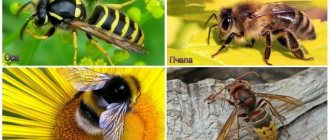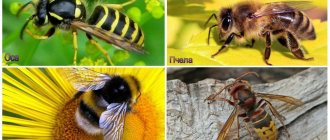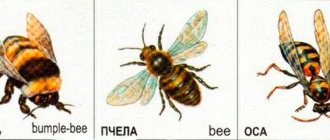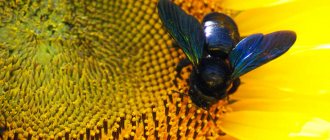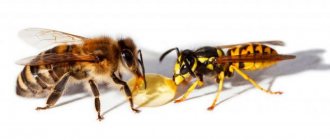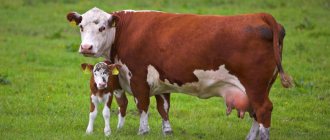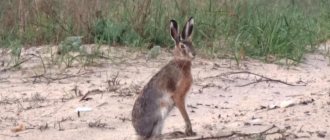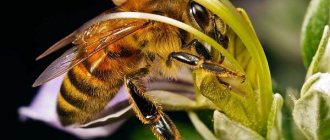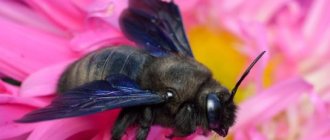Amazing insects that we very often encounter are wasps, bees, bumblebees, and hornets. How to distinguish them correctly, distinguish them in appearance. We study the life of insects and their behavior. How do their families differ, how do they build their nests and where do they winter. Do they attack each other and who is stronger. What danger do they pose to humans?
Nature gives us a lot of beautiful and amazing things, and insects are an integral part of it. There are a huge number of them and they are all unique in their own way. Some of the insects that people often encounter are wasps, bees, bumblebees and hornets.
We are wary of them because we know well that they can sting very painfully. Next, we will get to know them better, learn about their distinctive characteristics, lifestyle, behavioral characteristics, and also find out whether they actually pose a danger to humans.
What they look like
To be able to easily recognize an insect, you need to know what they look like, each of them has its own distinctive appearance characteristics, let’s get acquainted with them:
- Bee. They are distinguished by the most modest color. There is no sharp transition between the chest and abdomen, the body is shaggy. They have fairly thick legs, which are covered with hairs, and have small jaws.
- Wasp. We all know about the term “wasp waist” and this really only applies to this type of insect; there is a sharp transition between the abdomen and thorax. The body is more elongated and smooth. It has a fairly bright color of the body, there are bright yellow splashes on the black back, and the abdomen is painted with contrasting bright yellow and black stripes. The paws are yellow. The oral apparatus is equipped with fairly powerful mandibles.
- Bumblebee. It has a more impressive body size; its distinctive characteristic is the fluffy cover throughout the body. He also has a beautiful, bright color, has yellowish-red stripes, maybe with a red tint. Bumblebees are found in nature completely black.
- Hornet. They are the largest representatives, their body size can reach 5 cm. They are also distinguished by fairly large and powerful jaws. Outwardly, it resembles a wasp, but the striking difference between the hornet is the absence of a thin waist.
Appearance
Bee
The bee is distinguished by its discreet color and shaded black and yellow stripes. The body is shaggy, without a pronounced transition from the chest to the tummy, the legs are plump, black and shaggy, the jaws are small. The back is black with a yellow coating, the posterior segment of the body has dark yellow stripes. The size of the worker and the queen bee is different.
The main difference between a wasp and a bee is the presence of a waist. It has a sharp transition from the sternum to the tummy, the body itself is smooth and elongated. What distinguishes it from others is its color: in wasps it is bright and contrasting, the back is black, with yellow splashes, the rear segment of the body is striped, black and yellow. The paws are yellow, the jaws are massive.
Bumblebee
The bumblebee is many times larger and hairier than bees and wasps. It has wide red stripes on its brown body. There are also pure black bumblebees. The differences between the female and the male are the presence of antennae on the latter. The bumblebee, unlike other species, is a universal pollinator; its nests must be protected.
Hornet
The largest of all the insects described above. It has powerful jaws and a large body, the color is striped black and yellow, hornets grow up to 5 cm, the queens are usually larger than the males. It differs in body structure from the wasp in being less graceful. Although the hornet is a close relative of the wasp, there are individuals without stripes, with a uniform brown or orange color.
Lifestyle and nutrition
When it comes to bees, their diet consists solely of pollen and nectar. They feed with the help of a long proboscis, which is equipped with a mouthparts. Bumblebees and hornets also do not refuse nectar.
Hornets have a real sweet tooth and love berries and fruits, but their diet also includes small insects, which they can easily destroy with the help of their powerful jaws. It is worth saying that they are quite fearless, since there are cases when they even attacked small animals.
Wasps are also aggressors and true predators, but they are not as brave as hornets, since they never choose large victims. They often attack bees, but in this case it is not so easy to win.
The bees are already accustomed to the attacks of their opponents and have developed their own defense schemes, thanks to which they win. Wasps also have a sweet tooth; they love ripe fruits and berries, and their favorite delicacies are honey, jam, and syrup.
All these insects lead a gregarious lifestyle and live in large colonies. But bumblebees go in search of food alone, and it is also worth mentioning that they do this early in the morning, when other nectar lovers are still sleeping.
It's hard to believe, but they can spend 18 hours a day collecting food. Bees go in search of food in small groups, but wasps can gather in groups of up to 30 individuals.
Hornets also go for food alone, and they can easily cover a distance of 10 kilometers. If during such a walk they discover a beehive, they mark the place with a special secretary, which they allocate so that they can return here soon, but with their relatives.
When attacking a hive, they mercilessly kill the bees, biting off their heads and paws. The main prey is honey, which wasps also love. For this reason, insects cannot coexist side by side.
Certain blood types sting people more often
Those who smell good to mosquitoes and bumblebees are often stung. Mosquitoes are first attracted to components of human sweat. It's not just sweat, breath, or more specifically carbon dioxide that can attract mosquitoes to spy on their victims. Other odors that attract them are lactic acid, uric acid, body heat and ammonia.
This explains, for example, why athletes are more likely to be stung than other people, because they produce significantly more lactic acid during exercise. The composition of bacteria on the skin also plays an important role. Blood type 0
is the most popular according to tests by the Institute of Pest Control Technology.
Habitat
Domestic bees live in hives that humans build for them. Wasps are wild representatives, so they build their homes in trees, often in hollows. Bumblebees love more secluded places, one might say hidden from others, so they can choose an area in the ground to build a nest; less often, their houses are found in tree trunks and birdhouses. All representatives are found in different areas, this could be a forest, a summer cottage, a city park, or botanical gardens.
Hornets choose a variety of places to build nests; these can be the eaves of buildings, tree branches, hollows, or cracks in rocks. But wasps can make their home absolutely anywhere, on the branches of a bush, in the attic, in the stem of a plant, etc. The building material is tree bark, which they moisten with saliva, and it becomes soft; the nests they build look like thick paper.
Nest arrangement
If we talk about domestic bees, then a nest for them is built by beekeepers, in the form of a hive. Wild bees build nests on their own; they can be found in tree hollows or rock crevices.
Wasps use wood as nesting material, chewing it to create pliable nesting material. It is round, gray in color and papery. Most often they can be found on tree branches, they can make nests under the ceiling of outbuildings, and some species make nests in the ground.
Bumblebees can choose completely different places to build a nest, the most common of which are burrows of small animals and abandoned bird nests. Bumblebees begin to build their houses from wax, that is, from the first cells; for subsequent ones they use capsules that remain after the larvae hatch.
Differences between insects
These representatives are quite similar to each other, but at the same time they have many differences. They all have the ability to fly, they buzz, and each of them can sting painfully, in addition to which they secrete toxic poison. But they never attack just like that, only when they feel a threat to themselves or their family, this is how they defend themselves.
If you look at bees, it is worth noting their hard work; they are busy working all day long. In addition to collecting honey all day, they also build honeycombs, clean the hive, feed the young generation, provide ventilation to the hive, process and store the collected product.
The life cycle of a working individual is on average 1 month, but the younger generation grows up quickly and families are regularly replenished, so such a short life remains unnoticed by others.
Structural features
The main difference between a bee is the presence of a triangular head with the main part of the nervous system and brain concentrated in it. In the middle of the head, along the crown of the head, there is a suture, from which the compound (faceted) eyes of the insect are located on both sides.
From each individual hexagonal plate, a round tube extends into the depths, gradually narrowing downwards. The walls of the tube are covered with a membrane that allows light to pass through.
A branched nerve approaches each tube from below. The eye of a working insect consists of 4-5 thousand facets, the uterus - up to 5 thousand, and the drone - up to 6-8 thousand. Simple eyes are located on the crown of the head, and the so-called third eye is on the line of the epicranial suture. The peculiarity of the structure of the visual organs lies in the form of transmission and processing of external information.
The wasp has 2 pairs of membranous wings, and its body measures 1.5 cm to 10 cm. On the sides of the wasp’s head there are 2 large and complex eyes, giving the insect the ability to see simultaneously in different directions.
Below on the front side there is a forehead, from which 2 movable segmented antennae (antennae) extend. They contain olfactory organs, designed for their orientation in a dark space. With its antennae, the insect perceives humidity, temperature, and the level of carbon dioxide in the nest.
Differences between a bumblebee and a bee
These are close relatives who have a fairly wide habitat. In fact, they have a huge number of differences. In total, there are about 300 species of bumblebees that live throughout the continents. The hind legs of females have a very beautiful shiny coating.
From edge to fold, the paws are covered with villi, which serve as a basket for collecting pollen. They have a round abdomen, without folded edges. The sting has a tubular internal structure, through which the poison penetrates under the skin when a bite is applied. The sting is smooth without serrations, so it can sting repeatedly without causing any harm to itself.
In turn, there are about 20 thousand species of bees, some of which have not been studied by science to this day. We all know that they are major pollen collectors and honey producers, as well as plant pollinators. They have 3 pairs of legs; on the inside there are villi, which also serve as baskets for collecting pollen. Abdomen bent downward.
Unlike the previous representative, they have an empty sting covered with jagged edges. When a bite is applied, these barbs cling to the edges of the wound, from which the sting comes off along with part of the abdomen, and the bee soon dies.
Let's look at the visual differences:
- Bumblebees have a round body and are much larger in size; bees have an elongated body.
- Bumblebees have brighter colors.
- Bees are used in open areas to collect pollen and pollinate plants, while bumblebees are used in greenhouses.
- A bee can only sting once, but bumblebees can sting multiple times.
Flight Character
During their flight, wasps often make jerky movements, every now and then hovering in one place for a couple of moments. They are able to move almost at lightning speed a considerable distance from the place where they were just located. The exception is large wasps (scolia, hornets), their movements are not so fast.
The flight of bees is smoother, but bumblebees, on the contrary, fly heavily, rather slowly and with a low hum. For a long time there was an opinion that bumblebees generally fly contrary to the laws of aerodynamics.
Differences between a hornet and a wasp
The largest representative of the wasp family is the hornet. The length of its body can reach 5 centimeters. In addition to the size of the body, differences also apply to the structure of the body. Hornets have a large head, a fairly wide and large chest, which is darker in color, and the abdomen is also larger.
There are differences in the construction of nests, namely in the building material:
- Wasps. They use tree fibers to build their houses. They moisten them in their saliva and chew them, obtaining a pliable building material. From the outside, such a house resembles crumpled paper; such a house has numerous layers, with honeycombs placed in the lower part.
- Hornets. They use rotted stumps and wood as building materials. Their nests are dark brown in color.
Regarding the territories where they live, they can be found in all regions of the country except the northern ones. In some regions, hornets are considered an endangered species. Regarding wasps, they are considered useless stinging insects, which is completely unfair.
Hornets inflict very painful stings, during which they release paralytic poison, which is highly concentrated. If a person suffers from allergic reactions, a bite can cause anaphylactic shock and even be fatal.
Wasps are distant relatives of wasps and ants. They differ in that they do not care for their offspring at all, they lay eggs in cells, after which they seal them and never return to them.
They have a sting about 5 mm long. They attack people only for protection when they feel danger. They attack with powerful jaws and then use a sting. At one time they can bite and sting several times. They feed on nectar, pollen, fruit and tree sap, and their diet also includes caterpillars and spiders.
Differences between bees and bumblebees and wasps
Bumblebees have a round body covered with fluffy fibers; they are darker than wasps and larger. Wasps, in turn, can boast of a bright, provocative color. The diet of bumblebees and bees consists of nectar and pollen; they use their proboscis to feed.
The wasp is omnivorous; in addition to pollen and nectar, they feed on the juice of fruits and trees; their diet also includes small insects. They often attack bee hives, using strong and sharp jaws.
Honey production
Bee and bumblebee honey differ in the amount of minerals and proteins in their composition, and its consistency also differs. Bumblebee honey is thinner, but several times richer in composition. It lasts longer than bee honey. It is kept in the refrigerator so that it does not ferment.
Bees and bumblebees pollinate many plants over the summer; they are the real workhorses of the insect world.
Wasps do not collect nectar or pollen and do not produce honey. They sit on a flower only in search of food for the larvae, looking for aphids or other small insects. The destruction of small insect pests is considered their work merit. Bees feed their offspring only with nectar.
Who is stronger: a bumblebee or a wasp
Their differences lie in the nature of their behavior: if the wasp is quite aggressive and easily attacks an enemy who is much larger than it in size, then the bumblebee is a very peaceful insect, and only in extreme cases uses its weapon.
Quite often, wasps attack the nests of peace-loving bumblebees in order to steal their food supplies; they attack with the help of their jaws and stings. When the bumblebee family is healthy, they easily cope with the attackers, but if it is weak, the wasps win, and can kill not only the working individuals, but also the entire young generation.
general information
Not all insects lead a solitary lifestyle. Some of them live in large communities - families. These insects include bees, wasps, bumblebees and ants. We'll talk about their differences, similarities and lifestyles. Bees, wasps, and bumblebees belong to the order Hymenoptera (ants usually do not fly). Accordingly, they have certain similarities, but there are also plenty of differences. How many of you think about the difference between a bee and a wasp or a bumblebee? After all, outwardly they are almost identical.
In fact, it is not difficult to distinguish a bee from other insects by external signs. But this is provided that the insect sits motionless and allows you to examine itself. And this doesn't happen often.
A very useful book for grades 2-3.
Dear Parents! The stores “Labyrinth” and “Read the City” sell Andrei Pleshakov’s excellent atlas-identifier “From Earth to Sky.” In lessons on the surrounding world, and later in biology, this atlas will be useful to your child and you, more than once or twice.
The atlas itself is a beautifully designed publication with colorful illustrations and detailed descriptions of most representatives of our flora and fauna, including insects.
Knowing the difference between a bee wasp and a bumblebee is useful in order to correctly provide first aid in case of a sting. For example, if after an attack the sting remains in the skin, then it is a bee. And if there is nothing in the wound, but the bite site is very painful and swollen, then it is a wasp. And you have to try hard to get stung by a bumblebee. They have no time for you at all, they have their own lives. But after the attack they do not leave a sting in the wound.
Note: how to avoid a bite and how to provide first aid if you do get stung
Where do hornets and wasps spend the winter?
With the arrival of cold weather, wasps go for the winter; for this they need to find a secluded place. Most often they overwinter under the bark of a tree, in the cracks of outbuildings, hollows, and old stumps. Until this time, they must accumulate a large amount of nutrients, which will be gradually consumed throughout the winter. They leave the nest they build over the summer and never return to it.
In hornets, this process is almost identical, but there are differences. Over the summer, they build a nest and make nutritious food reserves, raising the young generation. With the arrival of autumn, the females leave the nest to mate and then find a secluded place for the winter. At that time, the workers begin to close all exits from the nest; throughout the winter they will remain inside and feed on the reserves they have made.
If severe frosts strike, unfortunately, the working individuals will die, but the queen will remain, and with the arrival of warmth, she will lay eggs and create a new swarm. Wintering involves deep and long sleep, which continues until early spring.
Females that left the colony in the fall, after hibernation, look for a new place to build a nest and create a separate colony. These amazing insects are listed in the Red Book as they are considered an endangered species.
